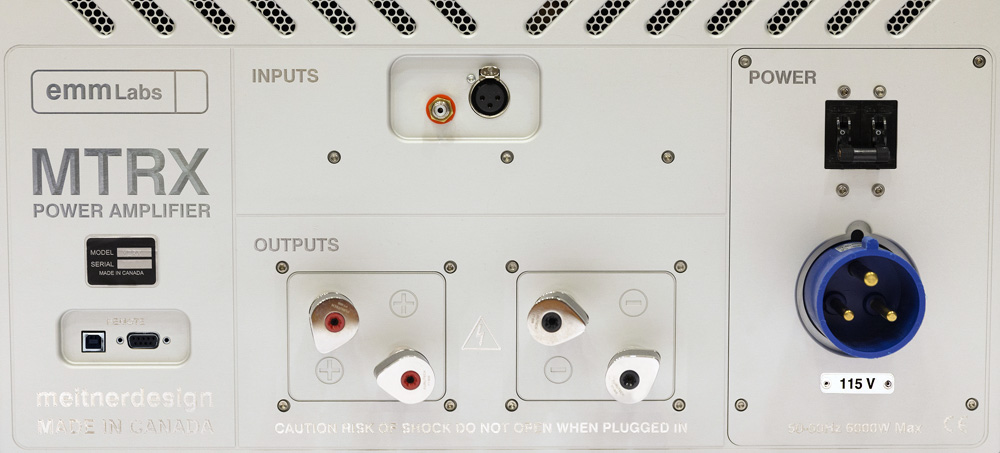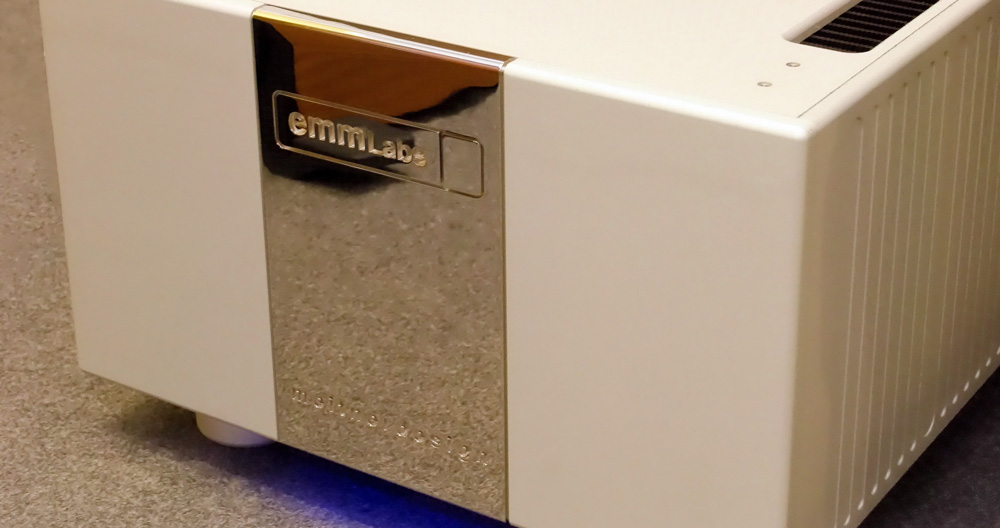Are we there yet?
After approximately two weeks, the EMM Labs MTRX were finally delivering the energy of the electric bass guitar and drum more to my satisfaction. Electric bass continued to lack the palpability that I so love and at times the upper bass and lower midrange seemed a hair muddy, though this could be an artefact of my listening room. The reverse side of this particular coin is that the EMM Labs were very kind to massed strings (Vanska, Beethoven 1st, BIS), were very extended at the frequency extremes, and were capable of extracting significantly more detail than any other amps with which I am familiar. BIS digital can be edgy, but the Beethoven was very easy to listen to and very emotionally involving with good presence.
Another night, I listened to P. J. Harvey’s Stories from the City, in particular Cut 7, “The Mess we’re In,” Cut 11 “Horses in My Dreams” and Cut 12 “We Float.” Guitars and keyboards on the EMM Labs MTRX had wonderfully rich timbres throughout, with Thom Yorke’s voice in particular (on “The Mess We’re In”) floating above them with almost breath-taking purity. I also listened to parts of David Sylvian’s “Everything and Nothing.” These artists (and they are most definitely that) are, at least in these recordings, deeply interested in the quality and variety of sounds and timbres they can combine, move around and use as expressive devices, as well as sensuous tickles to the ears. I have heard and enjoyed these discs enormously on many different systems. That night with the MTRX, the results bested them all. I heard everything and I didn’t want to stop. The end result was not clinical in any way. The sounds were all just there in a wide, wide sound field, perhaps as wide as I have heard. Of course, like any audiophile, I spent a few moments wondering, well, could perhaps the voice be a tad warmer, more present, as I know only the best tubes seem to be able to do? But then, I became lost in the sensuous embrace. This was as good a listening experience as I have ever had, as good as I can recall it ever getting.
As you might guess, the Labor Day weekend provided any number of opportunities to listen with friends. A reissue on 180 gram vinyl of an early Julie Christy mono release was terrifically satisfying, capturing Julie’s husky, silvery voice with a “right there,” “reach out and touch” presentation on the EMM Labs MTRX. This is the CISCO repressing of the first mono only version of the album, and this is one of those monos’s that on a great system can fool you. You feel as if you can tell where the various instrumental voices are on a narrower-than-usual soundstage, such that you really do not miss the stereo. The EMM Labs pulled this off flawlessly, so much so that it would have been so easy to put down the pen in favor of just listening to the music. The next record was a Louisville LP of Roger Sessions’ Symphony No. 7 which was issued in the 1970’s. This is a less common label that one might expect would be: a) not so pleasant sounding, and, b) relatively poor quality vinyl. Both prejudgments would, in this case, be mistaken. It is a minimally miked performance which was well mastered. The EMM Labs brought out the best in this challenging, thorny score. The soundstage was very wide, there was no hint of brightness or brittleness in the strings, instrument placement was reasonably well defined, and the bass drum and tympani whacks were full of punch. With the best tubes, one might hear a bit more velvet in the strings, and perhaps a slightly deeper soundstage, but with perhaps a bit less air and presence in the lower percussion.
At this point, I wanted to hear something less challenging and a bit more melodic, so I turned to an early EMI version of Delius’ “In Country Gardens.” I have seen pictures of the soundstage where this was recorded, a small church as I recall. The EMM Labs capture the close chamber ensemble sense very accurately. The soundstage was nevertheless of wonderful width as presented. This is a first pressing and has some pops and ticks, though the sound was terrific, far superior to the CD reissue. The EMM Labs MTRX did a superb job of sorting out the noise from the music in such a way that the former was quite easy to ignore. There are many solo wind passages, which were delineated with great clarity. This LP is highly regarded for its lush string tone.
The last two selections, at least for that evening, were the Michael Tilson Thomas Mahler Symphony No. 4 and Honneger’s Symphony No. 2 on a London recording, both on vinyl. I am among a (probably) small minority of listeners that find the Tilson Thomas Mahler recordings to suffer from a bit of digititis; by this I mean a bleaching/diminution of harmonics and overtones in conjunction with a subtle hardening at some frequencies. With the EMM Labs MTRX, the upper strings could get a bit grainy when pushed and the lower strings lacked a bit of richness and warmth; however, the detail was phenomenal.
The Honneger, which is a strings-only symphony, is one of Ansermet’s less flattering recordings of an otherwise generally illustrious body of work, regardless of what you may think of Ansermet as an interpreter. I thought that I would try my luck with this one. Some of the edge was less obvious, but it was still not a perfect experience. The strings were generally less shrill in the climaxes than I had heard before and the lower strings moved along in a rather satisfactory manner. The separation was excellent and the soundstage fairly wide. The second movement in particular contained some lovely moments. All in all, this was a very nice job by the EMM’s.
Final thoughts
Having the EMM Labs MTRX amps in my system for an extended period of time has helped me better understand the strengths and weaknesses of two very different approaches to design, namely single ended, direct heated triodes on the one hand, and ultra-high bandwidth, low distortion, extreme accuracy solid-state on the other. Each approach when taken to its extreme yields a sound that while different from the other, is highly musical and highly compelling. There is little doubt, at least in my mind, that the Meitner approach in almost all respects is the more neutral and accurate, certainly the more detailed, particularly in the topmost octaves. It also offers the lowest noise and distortion, the best extension at each frequency extreme, and the ability to drive almost any speaker regardless of how difficult a load it represents or how inefficient it may be. It also is the most dynamic at the loud end of the spectrum, so much so that you get a feeling of almost limitless power reserves, which, in turn, translate as a dynamic ease that lesser powered amps cannot approach. Perhaps as a further consequence, the EMM’s are able to exert a degree of control over dynamic drivers that must be heard to be fully appreciated. Should you choose the EMM Labs MTRX mono blocks, you can be assured that you have what I consider to be the finest solid-state amp made.The highest praise that a reviewer can give a product, is after having lived with it for an extended period to buy the review sample, which in this instance, I did.
- ← Previous page
- (Page 2 of 2)



Are they now in permanent residence?
You bought them?! Sheesh! Are they really better than Halcro(are they still relevant), Solution and Boulder?
The EMM amps are in the system for the long term, sitting next to the Balanced Kegons which I am keeping as part of my reference. With response to the Soulutions amps, I have not heard them in my home system so I must at this point withhold judgement. With respect to the Boulders, they are not my cup of tea and clearly are not competitive with the EMM’s. I now have spent extensive time with the amps on my Triolons and on the Marten Supreme 2 speakers and in both cases, the amps were superb.
Fred
What preamp are you using with these, or did I miss it in the review ?
I continue to use an Einstein tubed preamp in which I have substituted N.O.S. Siemens tubes from the 1970’s in place of the stock tubes on the inputs, replaced the stock power cord with one from Acapella, and replaced the feet with Finite Elemente Cerabases; however, I will be getting in the EMM Labs PRE as well as the Audio Note M10 Signature for review during the next several months, so things may change. I tend to change components infrequently, only when I find something which is significantly better.
Hello Fred,
A year has passed since you reviewed/acquired these MTRX amps. Have they continued to improve – particularly in the bass frequencies that you made note of in your review?
Also, have you stayed with the Cerabases, or have to tried anything else? Like Stillpoints perhaps?
Finally, have you had the opportunity to hear the MTRX2’s and if so, what was your perception of them?
No, this is the real “finally”…. any word on when/whether EMM Labs will be bringing out a linestage to match up with the MTRX/2’s and the TX-2/DA-2 gear.
Thanks for your time.
It is hard to believe that it has been a year since the initial MTRX review was published. They have in fact continued to improve but therein lies a story. My amps were early production. In the past year, there are been two updates which have been incorporated into the design and made available to all owners of the earlier amps. Ed Meitner installed both of these modifications into my amps. The first was a new input board which increased bandwidth from 500 KHz to 1 MHz and decreased settling time by half. The other was a change to the power supply for the input board (note that the input board has a separate power supply from the output section). The two updates taken together resulted in a rather audible improvement to the sound and addressed the perceived issues with the bass frequencies as well as increasing palpability and bass slam and dynamics which were already good.
I have stayed with the Cerebases and continue to be happy with them. The weight of the amps (230#) makes experimenting with feet a bit more difficult but this is something which I would like to explore. Stillpoints (particularly the Ultra 6’s would be an excellent choice). I have not heard the MTRX2 if by that you mean the smaller version of the amps (only 180# per side). I have spoken with Ed about them and I have every reason to believe that they incorporate the same circuitry but are only 1000 watts at 4 ohms vs 1500.
Finally the new preamp should be available early next year and I will be getting a review sample. In the interim, Ed has incorporated much of the technology in the latest version of the existing preamp.